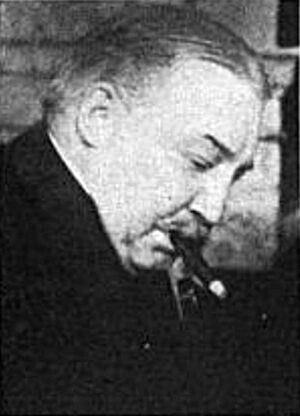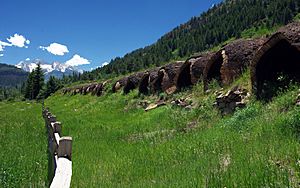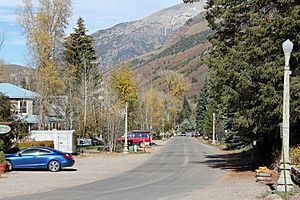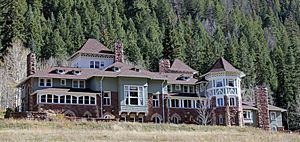Redstone Historic District (Colorado) facts for kids
Quick facts for kids |
|
|
Redstone Historic District
|
|
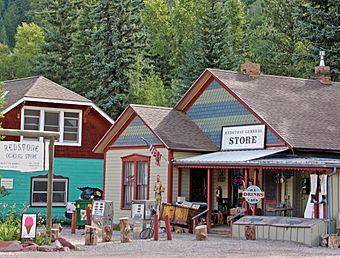
General store and adjacent cottage, 2010
|
|
| Location | Redstone, CO |
|---|---|
| Nearest city | Aspen |
| Area | 493 acres (200 ha) |
| Built | 1900–1903 |
| Architect | Theodore Boal |
| Architectural style | Various Victorian |
| MPS | Historic Resources of Redstone, Mining Industry in Colorado |
| NRHP reference No. | 89000934 |
| Added to NRHP | July 19, 1989 |
The Redstone Historic District is a special area in Redstone, Colorado. It includes the original town built for coal miners. In 1989, it became a historic district and was added to the National Register of Historic Places.
Redstone was once a "company town." This means a company, Colorado Fuel and Iron (CFI), built and owned most of the town. John Cleveland Osgood, the company's president, wanted to create nice homes for miners and their families. He also built public buildings. He hoped this would make workers happy and prevent them from forming unions.
Architect Theodore Boal designed the buildings. He used different Victorian styles. The district includes Osgood's large estate, Cleveholm, and the Redstone Inn. These are important historical buildings.
Redstone was very busy at first. This was because of the nearby coke ovens. These ovens turned coal into "coke," a fuel used to make steel. But within ten years, it became too expensive to move coke from Redstone. The town was almost empty.
A few people stayed, so Redstone did not become a ghost town. Some original buildings were torn down over time. Today, Redstone is a small arts community. Many old buildings have been fixed up. It is one of the few company towns left in Colorado that is still mostly complete.
Contents
Exploring Redstone's Location
The Redstone Historic District covers the original town area. It runs north to south along the Crystal River. The district is about one and a half miles long. Redstone Boulevard is the main street. It still has some of its original streetlamps.
The district's western edge follows Highway 133. It also follows the east bank of the Crystal River. The area is about 493 acres. This makes it the largest historic district in Pitkin County.
The district has 32 buildings. Most are small wooden cottages. Larger buildings are found along the mountain slopes. Two of the biggest buildings, Osgood Castle and the Redstone Inn, are also listed on the National Register.
A bridge crosses the river to Highway 133. This is the only road into Redstone. Across the bridge is the Redstone Coke Oven Historic District. These are the remains of the coke-making facilities. They provided many jobs when Redstone was busy.
Mountains over 12,000 feet tall surround Redstone. Their slopes are mostly undeveloped. They are part of the White River National Forest. The eastern slopes are also part of the Maroon Bells–Snowmass Wilderness. This wilderness separates Redstone from Aspen, the county seat, which is about 22.5 miles east.
Redstone's Past: A Timeline
The story of Redstone shows how the West grew with industries. First, people explored the area. Then, its natural resources were used for a short time of success. When the mining stopped, the town almost disappeared. But it survived by becoming a tourist spot.
Early Explorers (1700s–1860s)
The first Europeans came to the Crystal Valley in the 1830s. They were traders and trappers. John C. Frémont led American expeditions in the 1840s. Later, people looked for gold, but did not find much.
After the Civil War, treaties with the Utes made the area safer for settlers. The Utes were the Native American tribe who lived in the Crystal Valley. The government hoped to find valuable minerals here. A survey in 1873 found rich coal deposits in the mountains. This survey also named many mountains and streams.
Mining Begins (1880–1900)
In the 1880s, towns like Crystal and Schofield grew in nearby Gunnison County. They were built around silver and lead mines. By 1880, the Ute people had to leave their land for reservations. This opened the valley for more settlers and fortune seekers.
One of these people was John C. Osgood. He was looking at coal in Colorado for his company. The coal in the Crystal Valley was very good. So, Osgood started his own company, Colorado Fuel. He bought land, planning to use the coal to make high-quality coke.
To do this, Osgood needed to build roads and railroads. His company took steps to build them. But nothing much happened for a while. In 1892, Colorado Fuel merged with another company. They became Colorado Fuel and Iron (CF&I). This company became the biggest coal mining company in the West.
After some financial problems in the 1890s, Osgood finally had enough money. He could now develop the Crystal Valley. A strike by miners made Osgood strongly dislike unions.
A special narrow-gauge railroad track was built. It went 12 miles up to Coalbasin. Here, the coal was very pure. This coal was perfect for making coke. The town of Coalbasin was built there. Where this track met the main line in the valley, the town of Redstone was built. It was named after the red sandstone cliffs nearby.
A Model Company Town (1900–1903)
Almost 250 coke ovens were built. This made it the largest coke facility in Colorado. Many workers came from Eastern Europe. The miners were usually from Colorado.
In the 1800s, mining towns often had rough, self-built homes. Companies did not usually provide good housing. This often led to complaints from workers.
Osgood wanted to change this. He believed that happy miners would work better. They would also be less likely to strike. He was inspired by other company towns, like Pullman, Illinois. He decided Redstone would be a model town. He spent nearly $5 million (about $175 million today) to build it.
At first, miners lived in shacks near the coke ovens. Osgood wanted the new town on the other side of the river. He hoped workers would live "free of strife and want." CF&I even created a "Sociological Department." This department helped with education, training, housing, and communication.
Town Design
Redstone was a carefully planned town. It had two main streets: River Road (now Redstone Boulevard) and Hill Road. River Road went all the way to Osgood's estate. A special railroad track crossed the river. It carried passengers and goods to the town. This left the main track free for coal and coke. The town's shops were near the train station. The rest of the town was for homes.
Theodore Boal, who designed Osgood Castle, also designed Redstone's buildings. He used popular Victorian styles. He especially liked the Swiss chalet style. He added details from other styles, like Shingle Style and Tudorbethan.
The first small, one-story cottages were finished in 1901. They were for the coke oven workers. These homes were much better than the old shacks. They had painted clapboard or shiplap siding. They often had decorative half-timbering. Windows were usually double-hung. The roofs had wide overhangs to protect from weather. Inside, homes had three to five rooms.
These homes had modern features. They had electricity from a company-built hydroelectric plant. They also had running water. These were luxuries for workers at the time.
Larger buildings included the Redstone Inn. It was a 40-room dormitory for single workers. It had electricity, running water, telephones, a barbershop, and a reading room. The company store was a timber-frame building. Behind it was a park and Lake Gibb, where people could ice skate.
On Hill Road, near the store, was the school. It had a stone entrance tower. The company paid for teachers and books. The school had one of Colorado's first kindergartens. It also offered classes for adults. Parents could learn English. Wives could take "domestic science" classes, now called home economics.
The Redstone Club was a two-and-a-half-story building for fun. It had a billiard room, reading room, and a place to get drinks. The company had rules to limit too much drinking. Upstairs was a theater. The basement had showers and dressing rooms.
The Big Horn Lodge was across the river. It was used for company meetings and entertaining guests. It even had a bowling alley. The town also had a cemetery and public gardens. Families could grow vegetables and raise a cow. The company built a large barn for workers' animals.
Near the power plant was the firehouse. It was a two-story building with wood shingles. It had one hand-drawn fire pump.
Construction continued in 1902. Redstone gained national attention. It won an award at the St. Louis Exposition. The New York Times called it "The Ruby of the Rockies." They said it was "the most beautiful town in Colorado."
By 1903, 83 cottages were done. More homes were built south of town. These were for miners, managers, and office workers. They were on larger lots with better views. Mature trees were left, making the area look carefully planned.
The largest homes were for senior managers. They had great views and fancy decorations. Osgood and his wife, Alma, often visited the workers. Alma, known as Lady Bountiful, made sure the latest fashions were in the store.
Decline and Revival (1904–Present)
After construction, CF&I faced money problems. This was due to strikes elsewhere and big investments. Osgood lost control of the company to the Rockefeller family. He spent less time in Redstone. The new managers did not care as much about the town.
In 1908, CF&I decided to move all coke production to Pueblo. It was too costly to keep the Redstone facility open. The ovens closed that year. The Coalbasin mines closed the next. Families left quickly. Redstone became very small, with fewer than a dozen people.
Osgood closed his estate in 1913. He remained involved in mining. In 1924, Osgood returned to Redstone. He and his third wife, Lucille, started turning the castle into a resort. Osgood died the next year. Lucille finished the resort, but it failed during the Great Depression.
By 1941, only 14 people lived in Redstone. During World War II, many large buildings were torn down and sold. The town's decline stopped in 1942. Another company started coal mining in Coalbasin again. But many cottages were still torn down or moved.
Later, Aspen became a popular resort. Redstone then started to attract more residents and tourists. They liked its historic buildings. The Redstone Inn was fixed up and reopened. The castle also opened for tours. Some remaining cottages are now bed and breakfasts. The town is also home to a small group of artists.
Important Historic Buildings
Many original cottages and larger buildings from Redstone's busy years are gone. But some important ones remain. Two of them are even listed on the National Register by themselves.
- General Store, 292 Redstone Boulevard. This building was run by the Palace Company. It is a one-and-a-half-story wooden building. It had unique gables and diamond-paned windows. It was one of the best-equipped company stores.
- North Gatekeeper's Lodge, 58 Redstone Boulevard. This is one of two buildings that guarded Osgood's estate. It has a stone base and a cross-gabled roof. It has decorative trim and wide overhanging eaves.
- Osgood Castle, south end of Redstone Boulevard. Also known as Cleveholm or Redstone Castle. This was Osgood's large estate. It was designed by Boal. It has 42 rooms. Osgood and his wife chose the furniture from Europe. Famous guests like King Leopold II of Belgium and President Theodore Roosevelt visited. It was listed on the National Register in 1971. This was the first property in Pitkin County to be recognized.
- Power Plant, off Highway 133. This is the only historic building west of the river. It is mostly ruins now. It was a hydroelectric power plant. It is a rare early example of a power station.
- Redstone Inn, 82 Redstone Boulevard. This building was first a dormitory for single workers. It is a two-and-a-half-story building. It has a special clock tower that is a local landmark. After the mines closed, it was not used for a while. Later, it was fixed up and reopened as an inn. It was listed on the Register in 1980.



